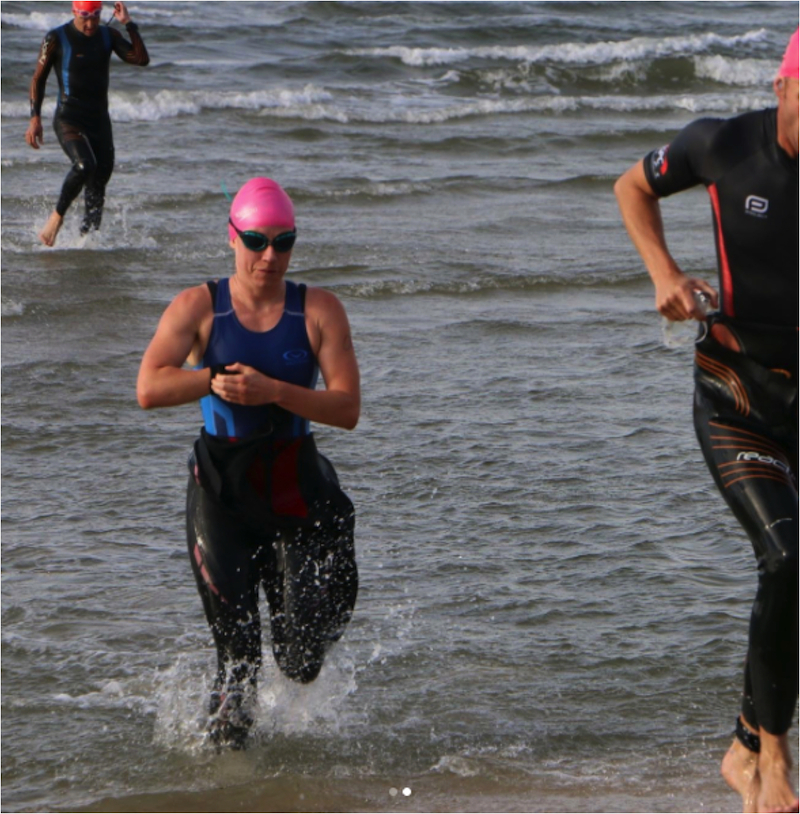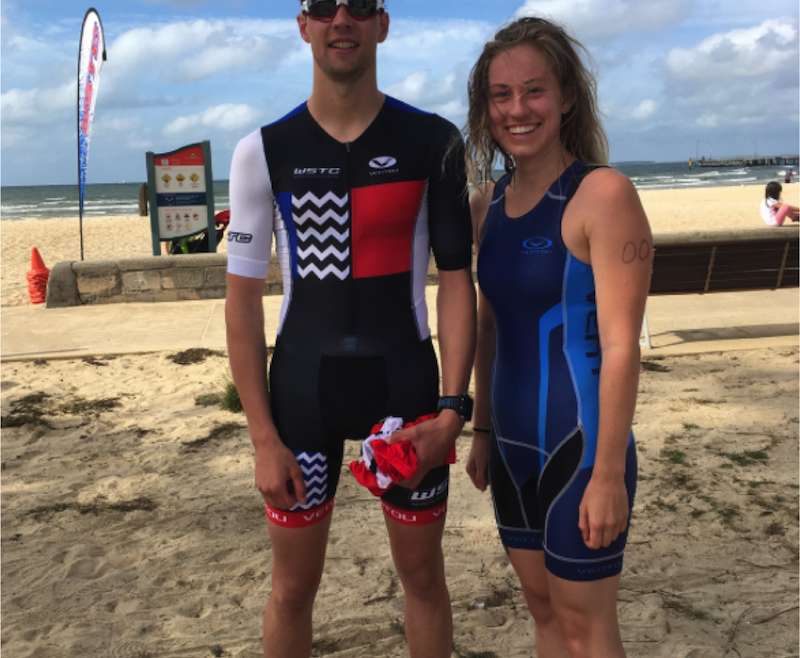Summer in Australia means it’s triathlon season. For anyone who has said they’d like to complete a triathlon one day, if you act now you’ve still got time to prepare for your race this season!
You might be thinking ‘there’s no way I can prepare in time’. But I assure this is not the case. Even if you haven’t even been running regularly over the holiday season or can’t remember the last time you rode a bike, there’s no need to stress out! You CAN do it.
I’ve prepared the following tips and a basic training plan that you can use to get ready for your first race, in only 4 weeks. Triathlons come in many different distances, so choose something appropriate for your experience. Common triathlon formats include:
- Sprint Distance: 500–750m swim, 20km cycle, 3–5km run
- Olympic Distance: 1500m swim, 40km cycle, 10km run
- Triathlon 70.3 (Half Ironman): 1900m swim, 90km cycle, 21.1km run
- Triathlon 140.6 (Ironman): 3900m swim, 180km cycle, 42.2km run
In this post, I’ll be outlining a basic training plan for your first sprint distance event.
Whilst I have a background in training, competing both as a swimmer and a triathlete when I was 16, the last time I raced was 7 years ago. Since then I’ve made very few attempts at serious swimming or cycling. However, with some gentle persuasion and encouragement from senior Osteopath and mentor, Brendan O’Loughlin, I was convinced to give it another go. Unfortunately, the timing of the event left me with just 4 weeks to get ready, so this is what I did to prepare for my first sprint distance triathlon in over 7 years…
WHAT YOU’LL NEED
- Swimming: swimsuit, cap and goggles.
- Cycling: bicycle (preferably a road bike, but not essential), cycling shoes & pedals (if you have them, but not essential), helmet, cycling clothes (ideally something with bum padding, but not essential).
- Running: sneakers, running clothes.
- Time!
WEEK 1
SWIM:
Find your local swimming pool and aim for 1–2 swims per week. Here is a beginners swimming set, which you can do at your own pace.
| Swim Set 1 | |
| Warm up: | 400–600m freestyle/backstroke |
| Main set: | 5x 100m @ 80% race pace – 30 seconds rest in-between (more or less if you need it) |
| Cool down: | 200m easy backstroke, 100m kick of choice, 200m easy swim |
RIDE:
Dust off your bicycle, and if you can, start by simply riding to and from work. If that’s not achievable, see if you can start riding to somewhere like the gym, instead of driving. Ideally you’re looking to find somewhere you can safely ride that is approximately 25–30 minutes each way. Otherwise, just go for a 45-minute ride 2–3 times during the first week.
RUN:
Running generally takes up the least amount of your time, but for me required the most effort.
Start small with something like a 3km run (about 20-minutes). Don’t be too hard on yourself if you need to stop and catch your breath, it won’t interfere with your training (trust me, I am the queen of stopping on runs). Try to do 2 runs in the first week, a few days apart.
WEEK 2–3
In the middle section of the program, the aim is to build up the distance. Try to build up to at least 2km in the pool and ride for a minimum of 1-hour. If convenient, ride somewhere with a few hills, like the Yarra Boulevard or similar. Aim to build up to a 5–7km run. You can also introduce some tempo runs (otherwise known as ‘comfortably hard’ runs – I know, is there really such a thing?).
You might even like to try a brick session – don’t worry, I’ll explain this soon if you’re not familiar with the term.
Here are some example training sessions that you might do during weeks 2–3:
SWIM:
| Swim Set 2 | Swim Set 3 | |
| Warm up: | 400m freestyle
200m freestyle with pull buoy |
200m freestyle
200m back stroke 200m kick with board |
| Main set:
|
8-10x 75m hard freestyle, 25m easy kick30 seconds rest in-between**Tri drill: 2 strokes normal, 1 stroke breathing with head up and looking ahead. |
2x 400m @ race pace
Tip: focus on your 3rd 100m being your hardest – don’t go too hard too early. 1-2 minutes rest in between Optional: 4x100m kick with board @ 80% |
| Cool down:
|
200m easy backstroke
400m freestyle (can mix up with pull buoy) |
200m freestyle with pull buoy
200m backstroke 100m easy whatever |
** When you are swimming in open water, you’ll need get used to looking up and ahead of you (as there’s no line to follow like when you’re in the pool). Rather than breathing to the side, you’ll need to swim like a water-polo player, lifting your head up and looking forward in-between strokes.
RIDE:
Brick session! This means a full bike session followed by a full running session. The easiest place to do this is at your gym. Try 30–40 minutes hard on the spin bike (after warming up) and then jump on the treadmill and run 5km. Try not to stop, it’s better to lower the speed if you’re tempted.
RUN:
5km tempo run: 1km warm up, 3km tempo @ 80% race pace, 1km cool down.
If you have the time and want to do a long run, in week 3 try an 8–10km run.
WEEK 4:
The week before the race! It is important that we arrive at the race healthy and rested so this week is all about maintenance, and recovery.
SWIM:
Try a session similar to what you did in week 1. Mix it up as you please.
If possible, it would be good to try an open water swim this week. Practise the breathing drill (looking up and forward in between strokes) we talked about earlier, as well as getting in and out of the water as quickly as you can. Some practice running on sand will also be useful.
RIDE:
2-3 comfortable rides of around 45-60 minutes duration, keeping your cadence (pedalling speed) up nice and high – ie. use a comfortable, easy gear.
RUN:
5km comfortable run early in the week and an easy 2-3km run towards the end of the week (around 2-3 days before the race).
RACE DAY!
TRANSITION TIPS:
There will a big compound (where competitors rack their bikes) that serves as the transition area between the swim/ride and ride/run legs.
Here are a few tips for setting up your transition area:
- Rack your bike up by hooking the brake levers over the metal bar.
- Lay a bright coloured towel down so you’ve got something to look for when entering transition.
- Lay your helmet upside down with the buckles out to either side so it’s easy to grab and put on.
- Lay your sneakers down with laces untied (unless you’re using elastic laces – which make shoes easier to slip on).
- If you’re using bike shoes and clip-in pedals you can choose to leave these clipped in to your pedals. But only do this if you’ve practised getting onto the bike and getting in to your shoes before race day. Otherwise, just leave your bike shoes on the ground. You can put them on and walk/run in them until it’s time to get on your bike.
Remember, you won’t be the only first timer AND everyone else will be feeling nervous too. But it’s okay. You’ve done the training, and you know what you need to do. Think of the delicious breakfast waiting for you at the finish line!

RACE TIPS:
- If you have a swimming wetsuit, this helps with buoyancy and will make the swim a bit easier. If not, then don’t worry, as you’ll save time in transition as they can be hard to get off!
- The open water swim can be rough with so many people swimming around you, but don’t panic. This is where you need to use those water polo strokes we practised, or alternatively, you can roll onto your back and do some backstroke if you’ve lost your breath.
- The ride leg is often a bit windy (because you’ll be near the beach), but it’s nothing you can’t handle.
- When you get off the bike, and out of transition, use the first few hundred meters to turn your legs over quickly. You may feel a bit wobbly doing this. The transition from riding to running can be hard, but this is why we did those brick sessions in training!
- For many, the run leg is the hardest mentally. Try to find your rhythm and just keep going.
Remember, you’ve done all these things in training so physically, you’re more than capable. It’s only your mind that questions your ability to keep going. If you do need to stop running and walk for a bit, don’t be too disheartened. Remember, you’ve just done an open water swim and bike ride!
It doesn’t matter how long it takes, or if you had to stop and catch your breath, it’s all about finishing what you set out to achieve. So just believe in yourself. Good luck!
If you like to speak with one of our practitioners about a training program, a particular event or anything else, please feel free to ask a question, contact us or email us at: [email protected]


